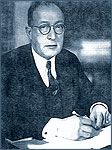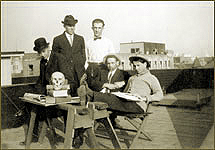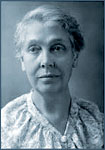Pioneering Education

 Pioneering education and research in osteopathic medicineDain Tasker, D.O. and Louisa Burns, D.O.After his graduation in 1898, Dain Tasker, D.O. was immediately recruited to teach theory and practice of osteopathy. This was quite a challenge as Dr. Moore and Dr. Burton, the initial teachers, had not put their lecture notes on paper and there were no publications by Dr. Still or the American School of Osteopathy available at that time. This frustration no doubt prompted Dr. Tasker to write his own book on osteopathic principles and practices, published in 1901. For years, it remained an essential text for the osteopathic profession. Prior to 1901, anatomy at the Pacific School was taught by palpation because there were no other means. Students palpated bony landmarks and related these to deeper structures. Palpation increased their confidence and understanding. They were not allowed to dissect cadavers until the legal recognition of Osteopathy in 1901. But even then they could hardly obtain sufficient number of cadavers because the four medical colleges had priority claims. The D.O.s acquired an amendment to the State Statute that cadavers would be proportioned to student enrollment. The D.O. college had 400 students (a greater number than the medical schools) and they received their proportion. Every student had to dissect a whole body. The second class of graduates at PSO included Dain’s sister, Anna E. Tasker, D.O. from Wisconsin. Women were drawn to osteopathy at a time when medical schools were not supportive of women enrollment. Student diversity was embraced by osteopathy in California since its early days. The graduation motto of the second class was “With brain and heart and hands to serve humanity”. Associated with a bankruptcy and yet another complete re-organization of PSO in 1904, the school changed its name again to Pacific College of Osteopathy (PCO). The college expressed a commitment to the “development of the true science of health” and began to facilitate the pursuit of research to advance education (see “Historical Outline, UCI-College of Medicine”, at the UC Irvine library, Special Collections and Archives). Struggles for educational privileges, better standards for research, and financial solvency continued. In 1909, PCO became the first osteopathic medical school to expand to a four year curriculum. The charter of PCO allowed to offer an M.D. degree, which it did from 1904-1910, to D.O. graduates who took an extra 6 months, or so, of course work in materia medica and other practices common to M.D.s of the time. In 1910, the American Osteopathic Association threatened the PCO with removal of accreditation if it continued to offer the M.D. degree and PCO withdrew the M.D. program thereafter. To educate other health practitioners and the public on osteopathy, they started publication of a monthly journal, The Osteopath, as early as July 1896. The front page of volume 1, number 1 explained that the “the object and aim of osteopathy are to improve and advance our present system of surgery, obstetrics, and treatments of general diseases to a more satisfactory position than they now are.” Dr. Tasker based many of his historical accounts on documentations in The Osteopath. One issue featured an article by Dr. Still, entitled “Osteopathy defined.” Still explained “The human body is a machine run by the unseen force called life and that it may be run harmoniously it is necessary that there be liberty of blood, nerves, and arteries from generating point to destination.” Dain Tasker explained that the social climate in California was favorable to Dr. Still’s philosophy of osteopathy because of a general distrust of drugs among the public. In 1897 efforts started for osteopathic schools nationwide to form an organization to regulate osteopathic education and to standardize the curricula. In January 1899, first mention can be found of an American Association for the Advancement of Osteopathy, in The Osteopath, 3 (6). This organization, founded in 1897, later became known as the American Osteopathic Association (AOA). Textbooks were vital in the beginning years of osteopathy in California to ensure uniformity and high quality education. In 1899 two authoritative text books appeared:
Textbooks apparently played a big role in the beginning years of osteopathy in California where practitioners were so far removed geographically from the main educational resources in Kirksville. When in San Francisco the California College of Osteopathy did not survive the destruction of the earthquake in 1906, osteopaths all over California donated text books to those who lost their libraries. This professional support and empathy apparently was important to Tasker, as he mentioned the event in his manuscript. Since he had worked so hard to promote the profession in California, practitioners donating their reference texts must have implied for him a strong group cohesiveness and identity among osteopaths in California. Louisa Burns, D.O. donated her time and resources to enhance education through research. In 1914 she had joined the A. T. Still Research Institute in Chicago. The research plans called for keeping experimental and control animals for long periods of time which required them to be in relatively good health. Conditions in Chicago at the Research Institute were found to be unsatisfactory for maintaining healthy animals. Therefore, it was decided to move the Institute to Sunny Slope in South Pasadena, California where the climate was milder and the facilities were away from an urban area. The move to Sunny Slope was completed in 1917 by Dr. Burns as Institute Director. Sunny Slope was purchased by the Burns family in 1917 for $8,000 to provide a place for the work of the A. T. Still Research Institute. Interest payments, taxes and some improvements during the years 1917-1919 were made by the Burns family. Gifts from various persons were used to purchase equipment and retire part of the mortgage. In 1918, Dr. Burns formulated a research thesis to test that “the abnormal condition, called a bony lesion, exists and may cause disease in distant parts of the body.” A corollary to this hypothesis was that if a bony lesion was a disturbance in the normal relation of bones, a similar condition could be produced in laboratory animals, either as a disturbance in bony relations or as some other pathological condition in distant parts of the body. The correction of such bony lesions should result in at least partial recovery from the diseases so produced. If the above conditions could be met, study of the tissue changes during the pathogenesis and recovery should increase the understanding of the nature of bony lesions. Dr. Burns attempted to correlate basic research with clinical phenomena by studying methods of correcting bony lesions and published her work about the pathogenesis of bony lesions, their effect on total body economy, and the specific effects on various organ systems of the body. She also contributed to the development of osteopathic skills of palpatory diagnosis and manipulative treatment. Her work is summarized in the book Pathogenesis of Vertebral Disease Following Vertebral Lesions, available at the archives of the Pumerantz Library at Western University of the Health Sciences in Pomona. Details about her contributions to pioneering research can be found in chapter 2 of the book “The Merger: M.D.s and D.O.s in California”, published by Xlibris in 2008. |